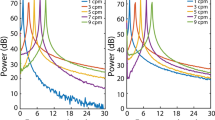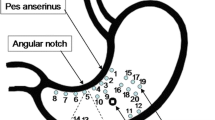Abstract
The object of this study was to elucidate what is actually measured in electrogastrography. Comparison of gastric signals simultaneously recorded from serosal and cutaneous electrodes in the conscious dog led to the following findings: 1. In the absence of phasic contractile activity and electrical response activity (ERA), the cutaneous recordings contained a frequency corresponding to the fundamental frequency of the electrical control activity (ECA) of the stomach (about 0.08 Hz). 2. Tachygastrias gave rise to cutaneous signals containing the tachygastric frequency (about 0.25 Hz). 3. The amplitude of the electrogastrogram increased when ERA occurred. It is concluded that both ECA and ERA are reflected in the electrogastrogram. A model is proposed that describes the electrogastrogram as the result of field potentials generated by depolarization and repolarization dipoles.
Similar content being viewed by others
References
Alvarez WC: The electrogastrogram and what it shows. J Am Med Assoc 78:1116–1119, 1922
Davis RC, Garafolo L, Gault FP: An exploration of abdominal potentials. J Comp Physiol Psychol 52:519–523, 1957
Nelsen TS, Kohatsu S: Clinical electrogastrography and its relation to gastric surgery. Am J Surg 116:215–221, 1968
Martin A, Moline J, Thouvenot J: Potentiels électriques dérivés à la surface de I'abdomen en relation avec I'activité antropylorique chez I'animal et chez I'homme. CR Soc Biol (Paris) 163:1423–1425 1969
Drieux C, Garnier D, Martin A, Moline J: Corrélation entre I'activité électrique de I'antre gastrique et I'électrogastroentérogramme du Cobaye. J Physiol (Paris) 73:A20, 1977
Tonkovic S, Thouvenot J, Penaud J: Electrosplanchnographical exploration of the digestive tract diseases. Digest 11th International Conference on Medical and Biological Engineering, Ottawa, 1976
Brown BH, Smallwood RH, Duthie HL, Stoddard CJ: Intestinal smooth muscle electrical potentials recorded from surface electrodes. Med Biol Eng 13:97–103, 1975
Smallwood RH: Gastrointestinal electrical activity from surface electrodes. Thesis, Sheffield, 1976
Thouvenot J, Penaud J, Morelle O: Sur les phénomènes électrophysiologiques des viscères: leur traduction à la surface cutanée. J Physiol (Paris) 65:A170–171, 1972
Besseling NC, van Maaren DCh, Kingma YJ: An implantable biotelemetry transmitter for six differential signals. Med Biol Eng 14:660–664, 1976
Code CF, Marlett JA: The interdigestive myoelectric complex of the stomach and small bowel of dogs. J Physiol (London) 246:289–309, 1975
Code CF, Marlett JA: Canine tachygastria. Mayo Clin Proc 49:325–332, 1974
Daniel EE: The electical and contractile activity of the pyloric region in dogs and the effects of drugs. Gastroenterology 49:403–418, 1965
Geddes LA: Electrodes and the Measurement of Bioelectric Events. New York: Wiley-Interscience, 1972
Papasova MP, Nagai T, Prosser CL: Two-component slow waves in smooth muscle of cat stomach. Am J Physiol 214:695–702, 1968
Szurszewski JH: Mechanism of action of pentagastrin and acetylcholine on the longitudinal muscle of the canine antrum. J Physiol (London) 252:335–361, 1975
Tiemann F, Reichertz P: Über das intestinale Elektrogramm (EIG) and seine Bedeutung für die Klinik. Med Klin 14:654–668, 1959
Sobakin MA, Smirnov IP, Mishin LN: Electrogastrography. IRE Trans Bio-Med Electron 9:129–132, 1962
Martin A, Moline J, Murat J: Apport de I'électrosplanchnographie (ESG) au diagnostic pré-opératoire d'une ulcération gastrique. Presse Med 28:1277–1278, 1971
Martin A, Thillier JL, Moline J: Effets de la section du vague sur la motricité gastrique chez I'homme. Etude électrogastroentérographique. J Physiol (Paris) 65:A145, 1972
Author information
Authors and Affiliations
Rights and permissions
About this article
Cite this article
Smout, A.J.P.M., Van Der Schee, E.J. & Grashuis, J.L. What is measured in electrogastrography?. Digest Dis Sci 25, 179–187 (1980). https://doi.org/10.1007/BF01308136
Received:
Revised:
Accepted:
Issue Date:
DOI: https://doi.org/10.1007/BF01308136




